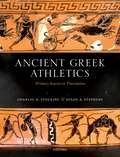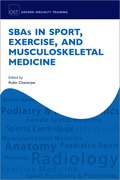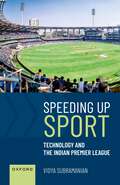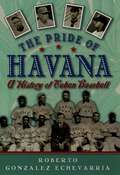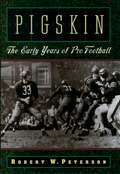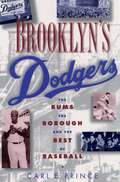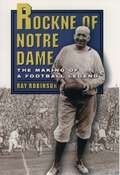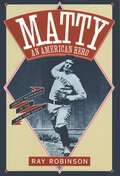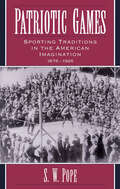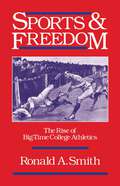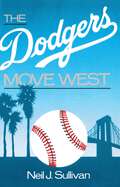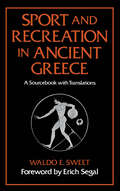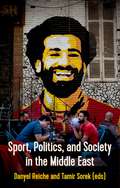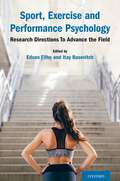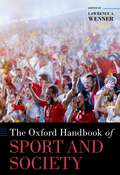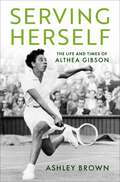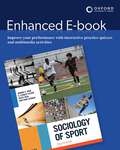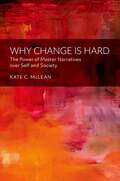- Table View
- List View
Ancient Greek Athletics: Primary Sources in Translation
by Charles H. Stocking Susan A. StephensThe Ancient Greek Athletics offers the most comprehensive collection to date of primary sources in translation for the study of ancient Greek athletics. Because Greek athletics was such an essential feature of both Greek and Roman culture, there is an especially strong need for proper treatment and understanding of the texts and other media used to reconstruct practices and ideologies of ancient athletics. The sources in this collection are arranged chronologically from the Archaic Period to the Roman Imperial Era, with an extensive appendix discussing key themes and topics. The organization and in-depth presentation of textual sources is designed to help students, scholars, and general readers fully appreciate the broader social and cultural significance of ancient Greek athletics as it developed in different historical time periods throughout antiquity.
Ancient Greek Athletics: Primary Sources in Translation
by Susan A. Stephens Charles H. StockingThe Ancient Greek Athletics offers the most comprehensive collection to date of primary sources in translation for the study of ancient Greek athletics. Because Greek athletics was such an essential feature of both Greek and Roman culture, there is an especially strong need for proper treatment and understanding of the texts and other media used to reconstruct practices and ideologies of ancient athletics. The sources in this collection are arranged chronologically from the Archaic Period to the Roman Imperial Era, with an extensive appendix discussing key themes and topics. The organization and in-depth presentation of textual sources is designed to help students, scholars, and general readers fully appreciate the broader social and cultural significance of ancient Greek athletics as it developed in different historical time periods throughout antiquity.
SBAs in Sport, Exercise, and Musculoskeletal Medicine (Oxford Specialty Training: Revision Texts)
by Robin ChatterjeeCandidates can prepare with confidence for postgraduate exams in sports and exercise medicine (SEM) with this revision guide. Containing over 400 SBA questions the content is carefully mapped to the Membership of Faculty of Sports and Exercise Medicine UK (MFSEM) curriculum ensuring comprehensive preparation. The Single Best Answer questions mirror the format of those candidates can expect to find in the MFSEM exam and many other postgraduate MSC SEM examinations globally. Explanatory answers include valuable background knowledge and references for further study. Each question and answer has been written to a high standard by some of the leading lights in SEM, orthopaedics, physiotherapy, rheumatology, radiology and musculoskeletal medicine as well as other specialties. Written by over 90 experts from the UK, Australia, the USA and Europe, this resource can help candidates preparing for entrance and final fellowship examinations of many international organisations including the ACSEP in Australia, UEMS in Europe and the CAQ in the USA. Providing a thorough assessment of the reader's Sports and Exercise Medicine knowledge, this is an invaluable resource for today's SEM student.
Speeding up Sport: Technology and the Indian Premier League
by Vidya SubramanianCricket has been the single most popular sport in India. In a technologically unmediated age, the game was played in the five-day test format. In 2007 though, the sport evolved itself into the Indian Premier League, an association that transformed it from mere a sport to an entertainment spectacle, raising its viewership, TRPs and popularity of the game, to hitherto unimaginable heights. The IPL consequently became India's first sporting platform. This book posits that the growth of the IPL (and of the popularity of cricket in contemporary India) has also been dependent on the parallel evolution of information and technology systems. The implications of technology have affected the way in which it can now be viewed by audiences on the television set at home; new technologies have affected umpiring decisions; new software are critically tied to generating digital audiences for the sport (it can be viewed on one's smartphone and e-devices); and in general, information and communication technology (ICT) has brought major interface between cricket players, administrators, brand managers, PR agencies and the audience. Developing ICTs as a real-time technological mediation has made the IPL dependent on the internet, television broadcast, Twitter, facebook and mobile phones. This book studies this impact; it studies not only how the sport has evolved in a post liberal India, but also how technology has affected the way it is viewed and spectated upon thereby altering the cultural and social milieu of the nation.
Speeding up Sport: Technology and the Indian Premier League
by Vidya SubramanianCricket has been the single most popular sport in India. In a technologically unmediated age, the game was played in the five-day test format. In 2007 though, the sport evolved itself into the Indian Premier League, an association that transformed it from mere a sport to an entertainment spectacle, raising its viewership, TRPs and popularity of the game, to hitherto unimaginable heights. The IPL consequently became India's first sporting platform. This book posits that the growth of the IPL (and of the popularity of cricket in contemporary India) has also been dependent on the parallel evolution of information and technology systems. The implications of technology have affected the way in which it can now be viewed by audiences on the television set at home; new technologies have affected umpiring decisions; new software are critically tied to generating digital audiences for the sport (it can be viewed on one's smartphone and e-devices); and in general, information and communication technology (ICT) has brought major interface between cricket players, administrators, brand managers, PR agencies and the audience. Developing ICTs as a real-time technological mediation has made the IPL dependent on the internet, television broadcast, Twitter, facebook and mobile phones. This book studies this impact; it studies not only how the sport has evolved in a post liberal India, but also how technology has affected the way it is viewed and spectated upon thereby altering the cultural and social milieu of the nation.
The Pride of Havana: A History of Cuban Baseball
by Roberto Gonzalez EchevarriaFrom the first amateur leagues of the 1860s to the exploits of Livan and Orlando "El Duque" Hernandez, here is the definitive history of baseball in Cuba. Roberto Gonzalez Echevarria expertly traces the arc of the game, intertwining its heroes and their stories with the politics, music, dance, and literature of the Cuban people. What emerges is more than a story of balls and strikes, but a richly detailed history of Cuba told from the unique cultural perch of the baseball diamond. Filling a void created by Cuba's rejection of bullfighting and Spanish hegemony, baseball quickly became a crucial stitch in the complex social fabric of the island. By the early 1940s Cuba had become major conduit in spreading the game throughout Latin America, and a proving ground for some of the greatest talent in all of baseball, where white major leaguers and Negro League players from the U.S. all competed on the same fields with the cream of Latin talent. Indeed, readers will be introduced to several black ballplayers of Afro-Cuban descent who played in the Major Leagues before Jackie Robinson broke the color barrier once and for all. Often dramatic, and always culturally resonant, Gonzalez Echevarria's narrative expertly lays open the paradox of fierce Cuban independence from the U.S. with Cuba's love for our national pastime. It shows how Fidel Castro cannily associated himself with the sport for patriotic p.r.--and reveals that his supposed baseball talent is purely mythical. Based on extensive primary research and a wealth of interviews, the colorful, often dramatic anecdotes and stories in this distinguished book comprise the most comprehensive history of Cuban baseball yet published and ultimately adds a vital lost chapter to the history of baseball in the U.S.
Pigskin: The Early Years of Pro Football
by Robert W. PetersonIf the National Football League is now a mammoth billion-dollar enterprise, it was certainly born into more humble circumstances. Indeed, it began in 1920 in an automobile showroom in Canton, Ohio, when a car dealer called together some owners of teams, mostly in the Midwest, to form a league. Unlike the lavish boardrooms in which NFL owners meet today, on this occasion the owners sat on the running boards of cars in the showroom and drank beer from buckets. A membership fee of $100 was set, but no one came up with any money. (As one of those present, George Halas, the legendary owner of the Chicago Bears, said, "I doubt that there was a hundred bucks in the room.") From such modest beginnings, pro football became far and away the most popular spectator sport in America. In Pigskin, Robert W. Peterson presents a lively and informative overview of the early years of pro football--from the late 1880s to the beginning of the television era. Peterson describes the colorful beginnings of the pro game and its outstanding teams (the Green Bay Packers, the New York Giants, the Chicago Bears, the Baltimore Colts), and the great games they played. Profiles of the most famous players of the era--including Pudge Heffelfinger (the first certifiable professional), Jim Thorpe, Red Grange, Bronko Nagurski, and Fritz Pollard (the NFL's first black star)--bring the history of the game to life. Peterson also takes us back to the roots of the pro game, showing how professionalism began when some stars for Yale, Harvard, and Princeton took money--under the table, of course--for their services to alma mater. By 1895, the money makers--still unacknowledged--had moved to amateur athletic associations in western Pennsylvania and subsequently into Ohio. After the NFL formed in 1920, pro football's popularity grew gradually but steadily. It burst into national prominence with the Bears-Redskins championship game of 1940. As one sportswriter put it: "The weather was perfect. So were the Bears." The final score was 73-0. Peterson shows how, after World War II, the newly-created All America Football Conference challenged the NFL. Though dominated by a gritty Cleveland team, the AAFC was never viewed by NFL teams as much of a threat. That is, not until 1950 when the two leagues merged, bringing about the Cleveland Browns-Philadelphia Eagles game in which the Browns buried the Eagles 35-10. An elegy to a time when, for many players, the game was at least as important as the money it brought them (which wasn't much), Pigskin takes readers up to the 1958 championship game when the Baltimore Colts beat the New York Giants in overtime. By that time, the great popularity of the game had moved from newspapers and radio to television, and pro football had finally arrived as a major sport.
Brooklyn's Dodgers: The Bums, the Borough, and the Best of Baseball, 1947-1957
by Carl E. PrinceDuring the 1952 World Series, a Yankee fan trying to watch the game in a Brooklyn bar was told, "Why don't you go back where you belong, Yankee lover?" "I got a right to cheer my team," the intruder responded, "this is a free country." "This ain't no free country, chum," countered the Dodger fan, "this is Brooklyn." Brooklynites loved their "Bums"--Pee Wee Reese, Jackie Robinson, Duke Snider, Roy Campanella, and all the murderous parade of regulars who, after years of struggle, finally won the World Series in 1955. One could not live in Brooklyn and not catch its spirit of devotion to its baseball club. In Brooklyn's Dodgers, Carl E. Prince captures the intensity and depth of the team's relationship to the community and its people in the 1950s. Ethnic and racial tensions were part and parcel of a working class borough; the Dodgers' presence smoothed the rough edges of the ghetto conflict always present in the life of Brooklyn. The Dodger-inspired baseball program at the fabled Parade Grounds provided a path for boys that occasionally led to the prestigious "Dodger Rookie Team," and sometimes, via minor league contracts, to Ebbets Field itself. There were the boys who lined Bedford Avenue on game days hoping to retrieve home run balls and the men in the many bars who were not only devoted fans but collectively the keepers of the Dodger past--as were Brooklyn women, and in numbers. Indeed, women were tied to the Dodgers no less than their husbands, fathers, brothers, and sons; they were only less visible. A few, like Pulitzer Prize-winning poet Marianne Moore and working class stiff Hilda Chester were regulars at Ebbets Field and far from invisible. Prince also explores the underside of the Dodgers--the "baseball Annies," and the paternity suits that went with the territory. The Dodgers' male culture was played out as well in the team's politics, in the owners' manipulation of Dodger male egos, opponents' race-baiting, and the macho bravado of the team (how Jackie Robinson, for instance, would prod Giants' catcher Sal Yvars to impotent rage by signaling him when he was going to steal second base, then taunting him from second after the steal). The day in 1957 when Walter O'Malley, the owner of the Brooklyn Dodgers, announced that the team would be leaving for Los Angeles was one of the worst moments in baseball history, and a sad day in Brooklyn's history as well. The Dodger team was, to a degree unmatched in other major league cities, deeply enmeshed in the life and psyche of Brooklyn and its people. In this superb volume, Carl Prince illuminates this "Brooklyn" in the golden years after the Second World War.
Rockne of Notre Dame: The Making of a Football Legend
by Ray RobinsonIn a mere twelve years, Rockne's "Fighting Irish" won 105 games, including five astonishing undefeated seasons. But Rockne was more than the sum of his victories--he was an icon who, more than anyone, made football an American obsession. The book gives us colorful descriptions of such Rockne teams as the undefeated 1924 eleven led by the illustrious Four Horsemen, and the 1930 squad, Rockne's last and greatest. A renowned motivator whose "Win one for the Gipper" is the most famous locker-room speech ever, Rockne was also football's most brilliant innovator, a pioneer of the forward pass, a master of the psychological ploy, and an early advocate of conditioning. In this balanced account, Rockne emerges as an exemplary and complex figure: a fierce competitor who was generous in victory and defeat; an inspiring father figure to his players; and a man so revered nationwide that when he died in a plane crash in 1931, at the height of his career, he was mourned by the entire country. "A solid portrait of one of football's most solid figures."--The New York Times Book Review
Matty: Christy Mathewson of the New York Giants
by Ray RobinsonWhen all-time pitching great Christy Mathewson died of tuberculosis in 1925 at the age of 45, it touched off a wave of national mourning that remains without precedent for an American athlete. The World Series was underway, and the game the day after Mathewson's death took on the trappings of a state funeral: officials slowly lowered the flag to half-mast, each ballplayer wore a black armband, and fans joined together in a chorus of "Nearer My God to Thee." Newspaper editorials recalled Mathewson's glorious career with the New York Giants, but also emphasized his unstinting good sportsmanship and voluntary service in World War I. The pitcher known to one and all as "Matty" or "Big Six" was as beloved for the strength of character he brought to the national pastime, as for his stunning 373 career victories. "I do not expect to see his like again," said his best friend and former manager, John McGraw. "But I do know that the example he set and the imprint he left on the sport that he loved and honored will remain long after I am gone." In Matty, Ray Robinson tells the story of a man who became America's first authentic sports hero. Until Mathewson, Robinson reveals, Americans loved baseball, but looked down on ballplayers and other athletes as hard-drinking, skirt-chasing ne'er-do-wells. Deprived of real-life role models, millions of readers followed the serialized exploits of Frank Merriwell, a fictional hero who excelled at sports from baseball to billiards and never drank, smoke, or swore. Robinson shows how an eager public greeted Mathewson as a flesh-and-blood version of Merriwell from his first year at Bucknell University, where he shone as star pitcher, premier field-goal kicker, and class president. Lured into the big leagues before he could graduate, the tall, handsome pitcher soon won over men, women and children with his sense of fair play and his arsenal of blazing fastballs, sweeping curves, and infamously deceptive fadeaway pitches. Robinson skillfully details the highlights of Mathewson's career, including his showdowns against the great batters of his day and his encounters with the young Brooklyn, Chicago, Pittsburgh and St. Louis teams. Here are the six remarkable days in October, 1905 when Mathewson became the only pitcher ever to hurl three straight shutouts in a World Series, and the afternoon at West Point when he won $50 in a bet that he could throw 20 of his best pitches to exactly the same spot. Robinson does not underplay Mathewson's occasional failings, but the most surprising aspect of this fascinating portrait is just how close America's first Hall of Fame pitcher came to living up to his image. Drawing on rare interviews, press clips, and long overlooked eyewitness accounts, Matty brings baseball's golden age to life--not only the great teams and the early superstars, but the long train trips between games, with cramped berths and no air conditioning; the small town ballplayers let loose amidst big city vice; and the two-bit gambling that eventually led to the infamous Black Sox Scandal of the 1919 Series (a scandal that might have escaped detection if the sportswriters in the press box with Mathewson had not been able to rely on his experienced eye for clues to how ballplayers might throw games). Offering rare insight into the making of an early twentieth century American hero, Matty is must reading for anyone who loves baseball.
Patriotic Games: Sporting Traditions in the American Imagination, 1876-1926 (Sports and History)
by S. W. PopeIn Patriotic Games, historian Stephen Pope explores the ways sport was transformed from a mere amusement into a metaphor for American life. Between the 1890s and the 1920s, sport became the most pervasive popular cultural activity in American society. During these years, basketball was invented, football became a mass spectator event, and baseball soared to its status as the "national pasttime." Pope demonstrates how America's sporting tradition emerged from a society fractured along class, race, ethnic, and gender lines. Institutionalized sport became a trans- class mechanism for packaging power and society in preferred ways--it popularized an interlocking set of cultural ideas about America's quest for national greatness. Nowhere was this more evident than the intimate connection established between sport and national holiday celebrations. As Pope reveals, Thanksgiving sports influenced the holiday's evolution from a religious occasion to a secular one. On the Fourth of July, sporting events infused patriotic rituals with sentiments that emphasized class conciliation and ethnic assimilation. In a time of social tensions, economic downturns, and unprecedented immigration, the rituals and enthusiasms of sport, Pope argues, became a central component in the shaping of America's national identity.
Sports and Freedom: The Rise of Big-Time College Athletics (Sports and History)
by Ronald A. SmithPerhaps more than any other two colleges, Harvard and Yale gave form to American intercollegiate athletics--a form that was inspired by the Oxford-Cambridge rivalry overseas, and that was imitated by colleges and universities throughout the United States. Focusing on the influence of these prestigious eastern institutions, this fascinating study traces the origins and development of intercollegiate athletics in America from the mid-nineteenth century to the early twentieth century. Smith begins with an historical overview of intercollegiate athletics and details the evolution of individual sports--crew, baseball, track and field, and especially football. Then, skillfully setting various sports events in their broader social and cultural contexts, Smith goes on to discuss many important issues that are still relevant today: student-faculty competition for institutional athletic control; the impact of the professional coach on big-time athletics; the false concept of amateurism in college athletics; and controversies over eligibility rules. He also reveals how the debates over brutality and ethics created the need for a central organizing body, the National Collegiate Athletic Association, which still runs college sports today. Sprinkled throughout with spicy sports anecdotes, from the Thanksgiving Day Princeton-Yale football game that drew record crowds in the 1890s to a meeting with President Theodore Roosevelt on football violence, this lively, in-depth investigation will appeal to serious sports buffs as well as to anyone interested in American social and cultural history.
The Dodgers Move West
by Neil SullivanFor many New Yorkers, the removal of the Brooklyn Dodgers--perhaps the most popular baseball team of all time--to Los Angeles in 1957 remains one of the most traumatic events since World War II. Neil J. Sullivan's controversial reassessment of a story that has reached almost mythic proportions in its many retellings shifts responsibility for the move onto the local governmental maneuverings that occurred on both sides of the continent. Conventional wisdom has it that Dodgers owner Walter O'Malley cold-heartedly abandoned the devoted Brooklyn fans for the easy money of Los Angeles. Sullivan argues that O'Malley had, in fact, wanted to stay in Brooklyn, hoping to build a new stadium with his own money. Situated in an increasingly unsafe neighborhood and without parking facilities, Ebbets Field had become obsolete. Yet an uncooperative New York City administration, led by Robert Moses, blocked O'Malley's plan to use the ideal site at the Atlantic Avenue Long Island Railroad terminal. A political battle over the Dodgers' move also erupted in Los Angeles. Mayor Poulson's suggestion to use Chavez Ravine as the new stadium site triggered opposition from residents concerned about a giveaway. Eventually a telethon campaign that enlisted the help of celebrities such as Groucho Marx, George Burns, and Ronald Reagan enabled the approval of the deal. Set against a backdrop of sporting passion and rivalry, and appearing over thirty years after the Dodgers' last season in Brooklyn, this engrossing book offers new insights into the power struggles existing in the nation's two largest cities.
Sport and Recreation in Ancient Greece: A Sourcebook with Translations
by Waldo E. SweetAimed at readers of all levels--from student to classics buff to serious scholars--this sourcebook looks at sport and recreation in ancient Greece through translated accounts of ancient Greek and Latin authors. It examines such diversions as the ancient Olympic Games, athletic clothing, women in sports, dining, dancing, and fishing. Sport and Recreation in Ancient Greece offers a wide range of topics geared to students' interests, new translations into readable English that facilitate their introduction to the subject, and a rich assortment of illustrations. The questions following each translation help students understand the passages, while the presentation of contradictory evidence challenges them to evaluate different points of view, both in the study of ancient culture and in their own daily lives. Successfully tested in college classrooms for a ten years, this book provides an excellent springboard for the study of ancient Greek history, classical literature, or sports history.
Sport, Politics and Society in the Middle East
by Danyel Reiche Tamir SorekSport in the Middle East has become a major issue in global affairs. The contributors to this timely volume discuss the intersection of political and cultural processes related to sport in the region. Eleven chapters trace the historical institutionalization of sport and the role it has played in negotiating "Western" culture. Sport is found to be a contested terrain where struggles are being fought over the inclusion of women, over competing definitions of national identity, over preserving social memory, and over press freedom. Also discussed are the implications of mega-sporting events for host countries, and how both elite sport policies and sports industries in the region are being shaped. Sport, Politics and Society in the Middle East draws on academic disciplines from the humanities and social sciences to offer in-depth, theoretically grounded, and richly empirical case studies. It employs diverse research methodologies, from ethnography and in-depth interviews to archival research, to make a lasting contribution to this critical subject.
Sport, Exercise and Performance Psychology: Research Directions To Advance the Field
by Edson Filho Itay BasevitchThis book presents the most pressing questions to advance the field of sport, exercise, and performance psychology. Organized around performance and learning, health and wellbeing, and cultural and professional considerations, expert contributors in the field summarize the state-of-the-art literature, including tables with five must-read papers in each chapter. The book then presents the 125 critical research questions that must be addressed to move the field forward. As the main source of research questions for senior scholars, graduate masters and doctoral students, and advanced undergraduate students working on research projects, this book is the ultimate guide to addressing theoretical, methodological, and applied research in the field.
Sport, Exercise and Performance Psychology: Research Directions To Advance the Field
by Edson Filho Itay BasevitchThis book presents the most pressing questions to advance the field of sport, exercise, and performance psychology. Organized around performance and learning, health and wellbeing, and cultural and professional considerations, expert contributors in the field summarize the state-of-the-art literature, including tables with five must-read papers in each chapter. The book then presents the 125 critical research questions that must be addressed to move the field forward. As the main source of research questions for senior scholars, graduate masters and doctoral students, and advanced undergraduate students working on research projects, this book is the ultimate guide to addressing theoretical, methodological, and applied research in the field.
The Oxford Handbook of Sport and Society (OXFORD HANDBOOKS SERIES)
by Lawrence A. WennerSport has come to have an increasingly large impact on daily life and commerce across the globe. From mega-events, such as the World Cup or Super Bowl, to the early socialization of children into sport, the study of sport and society has developed as a distinctly wide-ranging scholarly enterprise, centered in sociology, sport studies, and cultural, media, and gender studies. In The Oxford Handbook of Sport and Society, Lawrence Wenner brings together contributions from the world's leading scholars on sport and society to create the premier comprehensive and interdisciplinary reference for scholars and students looking to understand key areas of inquiry about the role and impacts of sport in contemporary culture. The Handbook offers penetrating analyses of the key ways that today's outsized sport is integrated into the lives of both athletes and fans and increasingly shapes the social fabric and cultural logics across the world. Featuring 85 leading international scholars, the volume is organized into six sections: society and values, enterprise and capital, participation and cultures, lifespan and careers, inclusion and exclusion, and spectator engagement and media. To aid comprehension and comparison, each chapter opens with a brief introduction to the area of research and features a common organizational scheme with three main sections of key issues, approaches, and debates to guide scholars and students to what is currently most important in the study of each area. Written at an accessible level and offering rich resources to further study each topic, this handbook is an essential resource for scholars and students as well as general readers who wish to understand the growing social, cultural, political, and economic influences of sport in society and our everyday lives.
The Oxford Handbook of Sport and Society (OXFORD HANDBOOKS SERIES)
by Lawrence A. WennerSport has come to have an increasingly large impact on daily life and commerce across the globe. From mega-events, such as the World Cup or Super Bowl, to the early socialization of children into sport, the study of sport and society has developed as a distinctly wide-ranging scholarly enterprise, centered in sociology, sport studies, and cultural, media, and gender studies. In The Oxford Handbook of Sport and Society, Lawrence Wenner brings together contributions from the world's leading scholars on sport and society to create the premier comprehensive and interdisciplinary reference for scholars and students looking to understand key areas of inquiry about the role and impacts of sport in contemporary culture. The Handbook offers penetrating analyses of the key ways that today's outsized sport is integrated into the lives of both athletes and fans and increasingly shapes the social fabric and cultural logics across the world. Featuring 85 leading international scholars, the volume is organized into six sections: society and values, enterprise and capital, participation and cultures, lifespan and careers, inclusion and exclusion, and spectator engagement and media. To aid comprehension and comparison, each chapter opens with a brief introduction to the area of research and features a common organizational scheme with three main sections of key issues, approaches, and debates to guide scholars and students to what is currently most important in the study of each area. Written at an accessible level and offering rich resources to further study each topic, this handbook is an essential resource for scholars and students as well as general readers who wish to understand the growing social, cultural, political, and economic influences of sport in society and our everyday lives.
Serving Herself: The Life and Times of Althea Gibson
by Ashley BrownA compelling narrative of the trials and triumphs of tennis champion Althea Gibson, a key figure in the integration of American sports and, for a time, one of the most famous women in the world. From her start playing paddle tennis on the streets of Harlem as a young teenager to her eleven Grand Slam tennis wins to her professional golf career, Althea Gibson became the most famous black sportswoman of the mid-twentieth century. In her unprecedented athletic career, she was the first African American to win titles at the French Open, Wimbledon, and the US Open. In this comprehensive biography, Ashley Brown narrates the public career and private struggles of Althea Gibson (1927-2003). Based on extensive archival work and oral histories, Serving Herself sets Gibson's life and choices against the backdrop of the Great Migration, Jim Crow racism, the integration of American sports, the civil rights movement, the Cold War, and second wave feminism. Throughout her life Gibson continuously negotiated the expectations of her supporters and adversaries, including her patrons in the black-led American Tennis Association, the white-led United States Lawn Tennis Association, and the media, particularly the Black press and community's expectations that she selflessly serve as a representative of her race. An incredibly talented, ultra-competitive, and not always likeable athlete, Gibson wanted to be treated as an individual first and foremost, not as a member of a specific race or gender. She was reluctant to speak openly about the indignities and prejudices she navigated as an African American woman, though she faced numerous institutional and societal barriers in achieving her goals. She frequently bucked conventional norms of femininity and put her career ahead of romantic relationships, making her personal life the subject of constant scrutiny and rumors. Despite her major wins and international recognition, including a ticker tape parade in New York City and the covers of Sports Illustrated and Time, Gibson endeavored to find commercial sponsorship and permanent economic stability. Committed to self-sufficiency, she pivoted from the elite amateur tennis circuit to State Department-sponsored goodwill tours, attempts to find success as a singer and Hollywood actress, the professional golf circuit, a tour with the Harlem Globetrotters and her own professional tennis tour, coaching, teaching children at tennis clinics, and a stint as New Jersey Athletics Commissioner. As she struggled to support herself in old age, she was left with disappointment, recounting her past achievements decades before female tennis players were able to garner substantial earnings. A compelling life and times portrait, Serving Herself offers a revealing look at the rise and fall of a fiercely independent trailblazer who satisfied her own needs and simultaneously set a pathbreaking course for Black athletes.
Serving Herself: The Life and Times of Althea Gibson
by Ashley BrownA compelling narrative of the trials and triumphs of tennis champion Althea Gibson, a key figure in the integration of American sports and, for a time, one of the most famous women in the world. From her start playing paddle tennis on the streets of Harlem as a young teenager to her eleven Grand Slam tennis wins to her professional golf career, Althea Gibson became the most famous black sportswoman of the mid-twentieth century. In her unprecedented athletic career, she was the first African American to win titles at the French Open, Wimbledon, and the US Open. In this comprehensive biography, Ashley Brown narrates the public career and private struggles of Althea Gibson (1927-2003). Based on extensive archival work and oral histories, Serving Herself sets Gibson's life and choices against the backdrop of the Great Migration, Jim Crow racism, the integration of American sports, the civil rights movement, the Cold War, and second wave feminism. Throughout her life Gibson continuously negotiated the expectations of her supporters and adversaries, including her patrons in the black-led American Tennis Association, the white-led United States Lawn Tennis Association, and the media, particularly the Black press and community's expectations that she selflessly serve as a representative of her race. An incredibly talented, ultra-competitive, and not always likeable athlete, Gibson wanted to be treated as an individual first and foremost, not as a member of a specific race or gender. She was reluctant to speak openly about the indignities and prejudices she navigated as an African American woman, though she faced numerous institutional and societal barriers in achieving her goals. She frequently bucked conventional norms of femininity and put her career ahead of romantic relationships, making her personal life the subject of constant scrutiny and rumors. Despite her major wins and international recognition, including a ticker tape parade in New York City and the covers of Sports Illustrated and Time, Gibson endeavored to find commercial sponsorship and permanent economic stability. Committed to self-sufficiency, she pivoted from the elite amateur tennis circuit to State Department-sponsored goodwill tours, attempts to find success as a singer and Hollywood actress, the professional golf circuit, a tour with the Harlem Globetrotters and her own professional tennis tour, coaching, teaching children at tennis clinics, and a stint as New Jersey Athletics Commissioner. As she struggled to support herself in old age, she was left with disappointment, recounting her past achievements decades before female tennis players were able to garner substantial earnings. A compelling life and times portrait, Serving Herself offers a revealing look at the rise and fall of a fiercely independent trailblazer who satisfied her own needs and simultaneously set a pathbreaking course for Black athletes.
Sociology of Sport
by George H. Sage D. Stanley Eitzen Becky Beal Matthew AtencioThis engaging, comprehensive textbook for sociology of sport courses takes a critical approach, focusing in particular on issues of power and inequality. By addressing questions such as "Are sports free of racism and sexism?" and "Who pays for, and who benefits from, sports?", students understand sport from a sociological perspective rather than as simply a spectator or participant.
The Examined Run: Why Good People Make Better Runners
by Sabrina B. LittleCan running make me a more moral person? Can striving to be a better person make me a better runner? In The Examined Run, philosopher and ultramarathon runner Sabrina B. Little asks whether running can be a laboratory for developing our character. She looks at the key ideas in virtue ethics--virtue, vice, exemplarism, moral emotions, and competition--and brings them into conversation with her experience in training and racing. Little pushes against the frequent conversations about ethics and sport that focus on the negative--doping and other forms of cheating or on simplistic expressions like ?no pain, no gain.? She argues that these ideas don't address the rich picture of how athletics inform a good life, and sport's relationship to acts of justice or courage. A good athlete is not just one who avoids cheating--rather, they perform feats of perseverance and courage, and succeed by working to develop their natural capacities. Little employs her own experiences in training, coaching, and racing in world class ultramarathons to reveal how athletics and virtue are deeply interconnected.
The Examined Run: Why Good People Make Better Runners
by Sabrina B. LittleCan running make me a more moral person? Can striving to be a better person make me a better runner? In The Examined Run, philosopher and ultramarathon runner Sabrina B. Little asks whether running can be a laboratory for developing our character. She looks at the key ideas in virtue ethics--virtue, vice, exemplarism, moral emotions, and competition--and brings them into conversation with her experience in training and racing. Little pushes against the frequent conversations about ethics and sport that focus on the negative--doping and other forms of cheating or on simplistic expressions like ?no pain, no gain.? She argues that these ideas don't address the rich picture of how athletics inform a good life, and sport's relationship to acts of justice or courage. A good athlete is not just one who avoids cheating--rather, they perform feats of perseverance and courage, and succeed by working to develop their natural capacities. Little employs her own experiences in training, coaching, and racing in world class ultramarathons to reveal how athletics and virtue are deeply interconnected.
